Home » P2500-P2599 Codes » P2588 P2588 Turbo Boost Control Position Sensor B Circuit Low
OBD-II Trouble Code Technical Description
Turbo Boost Control Position Sensor "B" Circuit Low
What does that mean?
This diagnostic trouble code (DTC) is a generic powertrain code, which means that it applies to OBD-II equipped vehicles that have a turbocharger (Ford, GMC, Chevrolet, Hyundai, Dodge, Toyota, etc.). Although generic, the specific repair steps may vary depending on make/model.
This trouble code can typically apply to all turbocharged OBDII equipped engines, but shows up more often in certain Hyundai and Kia vehicles. The Turbo Boost Control Position Sensor (TBCPS) converts the turbo boost pressure into an electrical signal for the Powertrain Control Module (PCM).
The Turbo Boost Control Position Sensor (TBCPS) provides additional turbo boost pressure information to the Powertrain Control Module or PCM. This information is typically used to fine-tune the amount of boost provided to the engine by the turbocharger.
The boost pressure sensor provides the PCM with the rest of the information needed for turbo boost pressure calculations. Anytime the voltage on the TBCPS sensor signal wire goes below a set level (usually under 0.3V), the PCM will set code P2588. This code is considered to be an electrical circuit fault only.
Troubleshooting steps may vary depending upon manufacturer, type of sensor and wire colors to the sensor. Refer to a vehicle specific repair guide to determine which is the "B" sensor for your particular vehicle.
Related turbo boost control position sensor "B" circuit codes:
P2586 Turbocharger Boost Control Position Sensor "B" Circuit P2587 Turbocharger Boost Control Position Sensor "B" Circuit Range/Performance P2589 Turbocharger Boost Control Position Sensor "B" Circuit High P2590 Turbocharger Boost Control Position Sensor "B" Circuit Intermittent/ErraticSymptoms
Symptoms of a P2588 code may include:
Malfunction Indicator Light On Poor performance Hesitation during acceleration Decrease in fuel economyCauses
Potential causes for this code to set are:
Short to ground in the signal circuit to the TBCPS sensor Short to ground in power circuit at TBCPS sensor- possible Failed TBCPS Sensor - possible Failed PCM - unlikelyDiagnostic and Repair Procedures
A good starting point is always to check for technical service bulletins (TSB) for your particular vehicle. Your issue may be a known issue with a known fix put out by the manufacturer and can save you time and money during diagnosis.
Next, locate the TBCPS sensor on your particular vehicle. This sensor is usually found directly screwed / bolted into the turbocharger housing. Once located, visually inspect the connector and wiring. Look for scraping, rubbing, bare wires, burn spots or melted plastic. Pull the connector apart and carefully inspect the terminals (the metal parts) inside the connector. See if they look burned or have a green tint indicating corrosion. Use electrical contact cleaner and a plastic bristle brush if cleaning of the terminals is needed. Let dry and apply electrical grease where the terminals contact.
If you have a scan tool, clear the diagnostic trouble codes from memory, and see if P2588 code returns. If it does not, then the connections were most likely your problem.
If the P2588 code does return, we will need to test the TBCPS sensor and its associated circuits. With the Key Off, disconnect the electrical connector at the TBCPS sensor. Connect a Digital Voltmeter black lead to the ground terminal at the TBCPS sensor wiring harness connector. Connect the red lead of the Digital Voltmeter to the power terminal at the TBCPS sensor wiring harness connector. Turn Key On Engine Off. Check man
Read: 20


